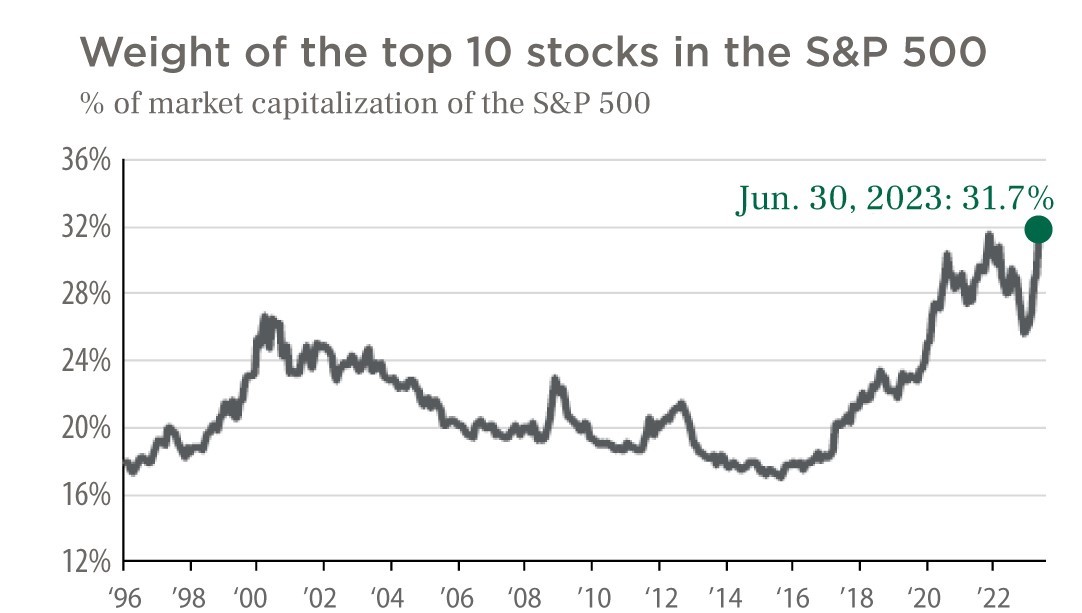As is always the case in the early days of a new calendar year, predictions on stock market performance entering 2023 were pervasive and dominated financial media. In January 2023, the optimism/pessimism dispersion of predictions was especially wide as bulls were making the case for a strong rebound from the declines in 2022 while bears were pointing to the dark clouds of recession. At the midpoint of 2023, clearly the bulls’ positive predictions are in the driver seat (so far), given the strong rebound in the S&P 500 and the historically strong uptrend in Nasdaq. But looking “under the hood” of the indices, driving this strength is disproportionately high contributions from a few stocks which include Apple, Microsoft, Nvidia, Meta (formerly Facebook), Alphabet, just to name a few. In fact, the top 10 stocks in the S&P 500 as of June 30th, 2023, now comprise almost 32% of the S&P 500 index’s value, a multi-decade high.

Source: JP Morgan Asset Management
Owners of these individual stocks (and not only in the index), have certainly benefited from the great runs of these strong companies this year. However, we believe it’s especially important for investors to take a closer look to evaluate the risk of holding too high of a concentration in just a few individual stocks. This is where psychology comes in: after such a strong run, the natural bias is to hold these names with the expectation that the recent success will persist into the future. That may or may not be true and is impossible to call. Adding to this aversion to sell is the tax burden to diversify, if held in a taxable account.
If history is our guide, we think it’s prudent to consider reducing portfolios overexposure to just a few names - the equivalent to the old saying “having all your eggs in one basket”. As always, we believe history and data help inform our decisions as to the most prudent way forward, which is especially important with the investment portfolio being the critical linchpin to the broader retirement and wealth planning strategy.
The Math on Individual Stock Performance
It’s important to first understand the historic risks associated with owning heavily concentrated positions, which, by some measures, becomes a concern when these holdings exceed around 5% of total net worth. In short, these risks are often underappreciated. In a recent study from Bernstein Research on the Russell 3000 from 1986 to 2022, the median stock underperformed the broader index of 3,000 stocks by more than 5% annually. About two-thirds of relative returns of individual stocks in the index underperformed, and 37% were actually negative in absolute terms. In fact, 39% of all stocks during this period suffered what’s considered a “catastrophic loss” of 50% of more and never recovered to their prior high. So, clearly a substantial portion of individual stocks have a high occurrence of underperforming the index and risk even substantial declines.
Some may argue “that’s only the bad companies” and “it doesn’t apply to the great companies,” but, again, history would argue otherwise. According to Dimensional Fund Advisors, since 1972, once a company grows to become one of the top 10 holdings in the S&P 500, they underperform the index going forward.
The Psychology of Holding Concentrated Positions
Now that we’ve covered the empirical left-brain angle, we must cover the -- equally important -- subjective, right brain considerations, which, more often than not, override all the data-driven rationale.
- Acknowledge Recency Bias: This is the strong inclination of investors to project forward what has recently occurred in the past. As noted by the data detailed earlier, this is a dangerous mindset, and, as objective wealth advisors to our clients, one we feel obligated to call out and emphasize as a potential blind spot in our clients’ portfolio strategy.
- Accept the Implied Tax Liability: If held in a taxable account, the value of large and overly concentrated positions with low costs basis (and large unrealized capital gains) are a mirage. Why? Because the reality of the situation is there is an implied liability in the form of a deferred tax capital gains liability, which investors should acknowledge and subtract from the value of the portfolio. The liability can be as high as 23.8% (top long term capital gain rate with the net investment income surtax), and sometimes it’s easier to just factor in this liability to Uncle Sam as deferred debt on the family balance sheet. The alternative is to hold these assets and take on the risk with the intention of passing the investments to heirs at death. This has substantial tax advantages because heirs would receive a “step up” in basis, which means their new cost basis would be priced as of the date of death and could be a presumably higher value than the original cost basis. If the heirs were to sell the shares shortly after the “step up” (i.e., within weeks or days), there could be minimal tax liability, which is a substantial tax advantage if the decedent was willing to take on the risk during their lifetime.
- Consider the Asymmetric Impact: Finally, we believe it’s useful to walk through a mindset exercise and consider one’s lifestyle in two scenarios. For example, let’s say a family has $5 million in investible assets with $3 million concentrated in one low basis stock. If that single holding were to decline 50% (not unrealistic), wouldn’t a $1.5 million decline in net worth (from $5 million to $3.5 million) radically change how a retiree or soon-to-retire person plans their spending? More than likely, yes. Conversely, would a 50% increase of that stock (to $4.5 million) and a net worth increase from $5 million to $6.5 million radically change one’s lifestyle and spending to the upside? In our experience, most of the time, the answer is no. Other than having to worry even more about overexposure to a single company, which in this case would comprise 70% of investible assets in the upside scenario, this may not create a radical change in lifestyle.
Strategies to Manage These Positions
So, what to do? What are some strategies to balance the impacts of a disastrous drop in the portfolio versus the tax liability? There are several tactics to employ, and they do not have to be executed in isolation. In fact, we think a well-thought-out mix of several of the following strategies might be the best path to address this thorny issue.
- Systematic Selling Plan: If the concentrated position is in a taxable account and has large unrealized gains, a systematic and intelligent navigation of the tax brackets across multiple tax years would be prudent. This would require an in-depth tax analysis and should be executed with the partnership of a CPA or tax advisor. The goal is to spread out these taxable gains over multiple tax years to limit the damage to cash outflows (for the tax liability), while potentially keeping the capital gains tax rate below the maximum 23.8%.
- Charitable Strategies: If a family is already charitably inclined, low basis concentrated positions in taxable accounts are a great candidate to employ to fund meaningful causes. Again, we suggest working with a knowledgeable tax advisor. Every one of these tactics could comprise an entire article by themselves, but below is a brief overview of each:
- Donor Advised Fund: A dedicated charity account can receive low basis stock; the donor gets a tax deduction on the gross amount (subject to AGI limitations) and the donor advised fund can sell the shares without capital gains tax. This is a great tool but is irrevocable. Once the donation is made, it can’t be pulled back.
- Donate Charitable Remainder Trusts (CRT): Funds can be donated to a CRT in exchange for annual taxable payments (fixed or variable) to the donor. The income tax deduction equals the value of the assets transferred less the present value of the expected CRT payments. There are many complexities with this strategy, and we believe this shouldn’t be executed without a trusted advisor.
- Gift to Family or Friends: Low basis shares can be gifted directly to friends or family. There is no tax deduction for the donor, and this isn’t taxable to the recipient, but the recipient does “inherit” the low costs basis, which effectively transfers the implied tax liability. The annual limit to gift in 2023 is $17,000 from one person to another. Anything above that requires the donor to file a gift tax return to reduce the lifetime estate tax exclusion for the donor.
- Options Strategies: Protective Puts; Covered Calls, Collars: The various options strategies are beyond the scope of this article, and there are many advantages and disadvantages to consider. But, in short, protective puts can be purchase to “lock in” a selling price to protect a downside move while selling covered calls can add extra income to the portfolio but limits the upside to the shares. A collar strategy employes a combination of puts and calls, which effectively limits the upside and the downside on the shares. All these options strategies require continual maintenance (as options expire), costs to purchase the options, and liquidity considerations with respect to the underlying shares.
- Back into your “Catastrophic Number”: For some with relatively modest spending needs, this might be the most practical solution for many approaching or in retirement. In short, this means effectively doing the math on the total liquid net worth needed to reasonably fund living expenses for the rest of your life. This is your Catastrophic Number. Once we know that, one could sell down the concentrated position in an amount to the level of the Catastrophic Number to ensure a confident retirement. Of course, this requires paying the associated tax bill. Anything above the Catastrophic Number can then be maintained with the concentrated holdings, but, this time, with the confidence that even if the concentrated holding went to $0, retirement isn’t at risk. The only thing at risk after executing this strategy is the assets that were earmarked for family inheritance and/or charities – effectively transferring the risk to those parties after death.
Bottom Line:
Concentrated positions are a great problem to have because it usually means extremely strong growth, but there are many factors to consider when managing this situation prudently. Handling these situations is a case study of how the integration of investment management, tax planning, estate planning, and cash flow is critical. But that’s just math. The mindset is equally important because, without the psychological impetus to actually proceed with executing the recommended tactics, the math means nothing at all.

